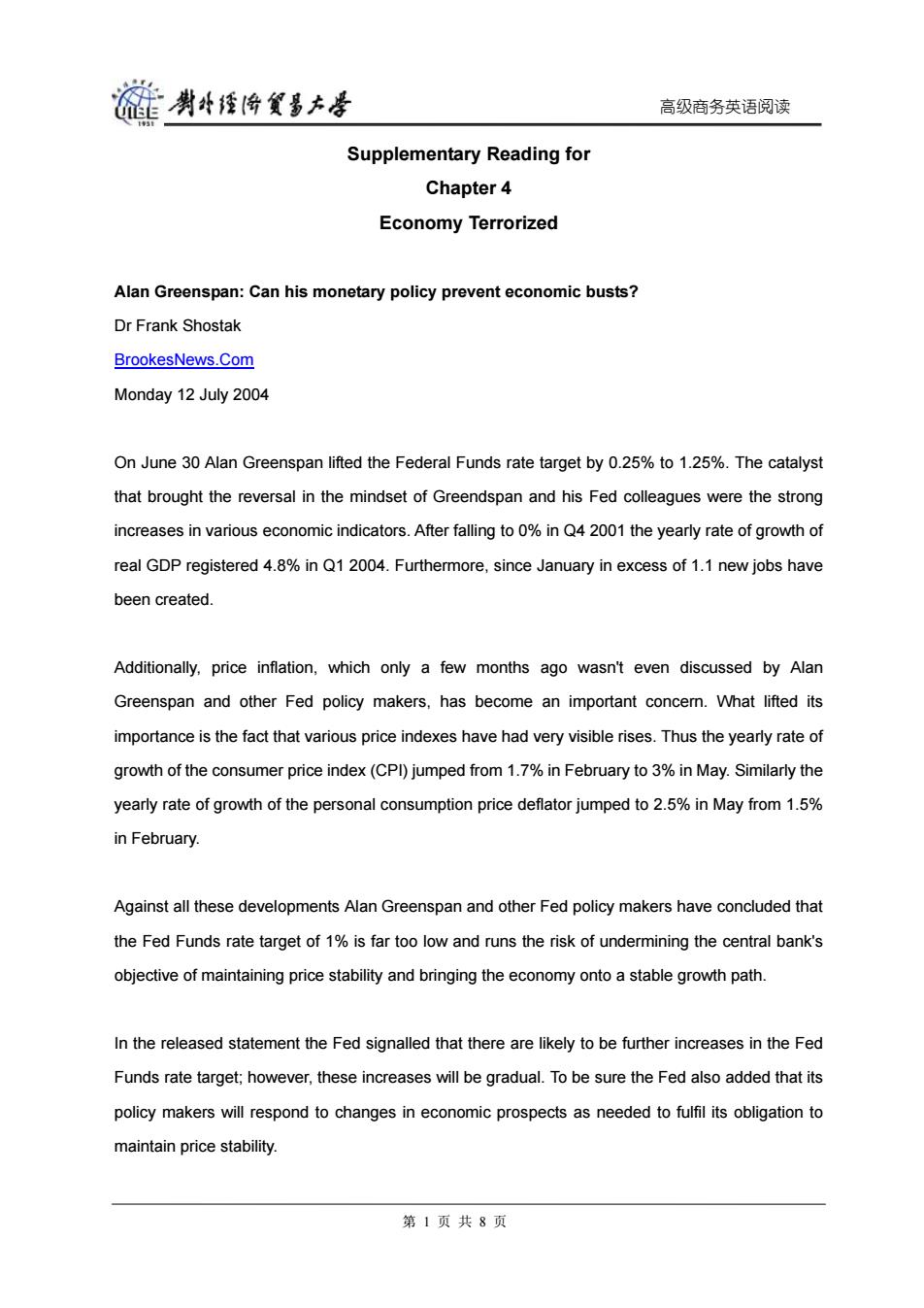
莲喇母矮将贸多大学 高级商务英语阅读 Supplementary Reading for Chapter 4 Economy Terrorized Alan Greenspan:Can his monetary policy prevent economic busts? Dr Frank Shostak BrookesNews.Com Monday 12 July 2004 On June 30 Alan Greenspan lifted the Federal Funds rate target by 0.25%to 1.25%.The catalyst that brought the reversal in the mindset of Greendspan and his Fed colleagues were the strong increases in various economic indicators.After falling to 0%in Q4 2001 the yearly rate of growth of real GDP registered 4.8%in Q1 2004.Furthermore,since January in excess of 1.1 new jobs have been created. Additionally,price inflation,which only a few months ago wasn't even discussed by Alan Greenspan and other Fed policy makers,has become an important concern.What lifted its importance is the fact that various price indexes have had very visible rises.Thus the yearly rate of growth of the consumer price index(CPI)jumped from 1.7%in February to 3%in May.Similarly the yearly rate of growth of the personal consumption price deflator jumped to 2.5%in May from 1.5% in February. Against all these developments Alan Greenspan and other Fed policy makers have concluded that the Fed Funds rate target of 1%is far too low and runs the risk of undermining the central bank's objective of maintaining price stability and bringing the economy onto a stable growth path. In the released statement the Fed signalled that there are likely to be further increases in the Fed Funds rate target;however,these increases will be gradual.To be sure the Fed also added that its policy makers will respond to changes in economic prospects as needed to fulfil its obligation to maintain price stability. 第1页共8页
高级商务英语阅读 Supplementary Reading for Chapter 4 Economy Terrorized Alan Greenspan: Can his monetary policy prevent economic busts? Dr Frank Shostak BrookesNews.Com Monday 12 July 2004 On June 30 Alan Greenspan lifted the Federal Funds rate target by 0.25% to 1.25%. The catalyst that brought the reversal in the mindset of Greendspan and his Fed colleagues were the strong increases in various economic indicators. After falling to 0% in Q4 2001 the yearly rate of growth of real GDP registered 4.8% in Q1 2004. Furthermore, since January in excess of 1.1 new jobs have been created. Additionally, price inflation, which only a few months ago wasn't even discussed by Alan Greenspan and other Fed policy makers, has become an important concern. What lifted its importance is the fact that various price indexes have had very visible rises. Thus the yearly rate of growth of the consumer price index (CPI) jumped from 1.7% in February to 3% in May. Similarly the yearly rate of growth of the personal consumption price deflator jumped to 2.5% in May from 1.5% in February. Against all these developments Alan Greenspan and other Fed policy makers have concluded that the Fed Funds rate target of 1% is far too low and runs the risk of undermining the central bank's objective of maintaining price stability and bringing the economy onto a stable growth path. In the released statement the Fed signalled that there are likely to be further increases in the Fed Funds rate target; however, these increases will be gradual. To be sure the Fed also added that its policy makers will respond to changes in economic prospects as needed to fulfil its obligation to maintain price stability. 第 1 页 共 8 页
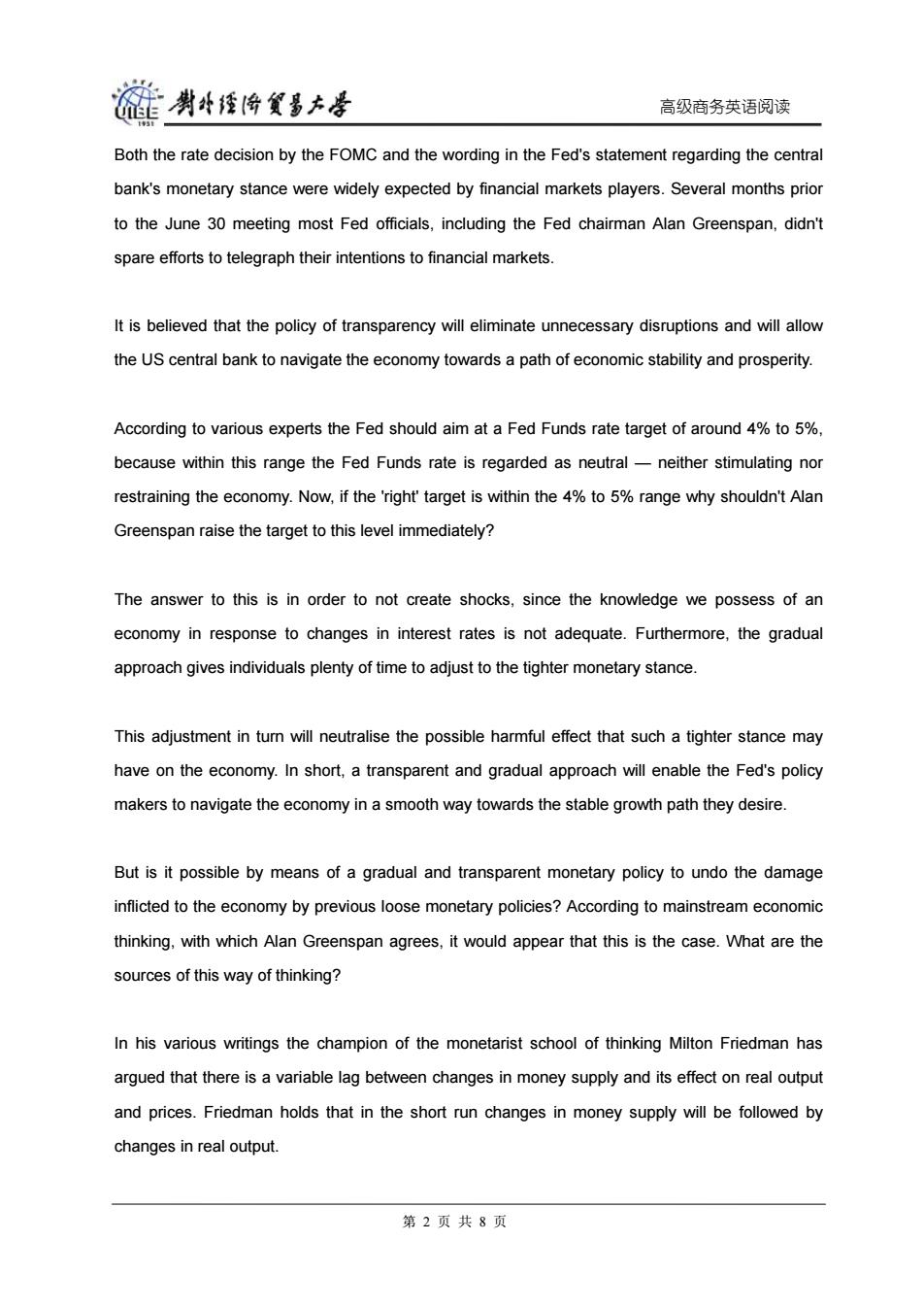
链男母经降贸多大量 高级商务英语阅读 Both the rate decision by the FOMC and the wording in the Fed's statement regarding the central bank's monetary stance were widely expected by financial markets players.Several months prior to the June 30 meeting most Fed officials,including the Fed chairman Alan Greenspan,didn't spare efforts to telegraph their intentions to financial markets. It is believed that the policy of transparency will eliminate unnecessary disruptions and will allow the US central bank to navigate the economy towards a path of economic stability and prosperity. According to various experts the Fed should aim at a Fed Funds rate target of around 4%to 5%, because within this range the Fed Funds rate is regarded as neutral-neither stimulating nor restraining the economy.Now,if the 'right'target is within the 4%to 5%range why shouldn't Alan Greenspan raise the target to this level immediately? The answer to this is in order to not create shocks,since the knowledge we possess of an economy in response to changes in interest rates is not adequate.Furthermore,the gradual approach gives individuals plenty of time to adjust to the tighter monetary stance. This adjustment in turn will neutralise the possible harmful effect that such a tighter stance may have on the economy.In short,a transparent and gradual approach will enable the Fed's policy makers to navigate the economy in a smooth way towards the stable growth path they desire. But is it possible by means of a gradual and transparent monetary policy to undo the damage inflicted to the economy by previous loose monetary policies?According to mainstream economic thinking,with which Alan Greenspan agrees,it would appear that this is the case.What are the sources of this way of thinking? In his various writings the champion of the monetarist school of thinking Milton Friedman has argued that there is a variable lag between changes in money supply and its effect on real output and prices.Friedman holds that in the short run changes in money supply will be followed by changes in real output. 第2页共8页
高级商务英语阅读 Both the rate decision by the FOMC and the wording in the Fed's statement regarding the central bank's monetary stance were widely expected by financial markets players. Several months prior to the June 30 meeting most Fed officials, including the Fed chairman Alan Greenspan, didn't spare efforts to telegraph their intentions to financial markets. It is believed that the policy of transparency will eliminate unnecessary disruptions and will allow the US central bank to navigate the economy towards a path of economic stability and prosperity. According to various experts the Fed should aim at a Fed Funds rate target of around 4% to 5%, because within this range the Fed Funds rate is regarded as neutral — neither stimulating nor restraining the economy. Now, if the 'right' target is within the 4% to 5% range why shouldn't Alan Greenspan raise the target to this level immediately? The answer to this is in order to not create shocks, since the knowledge we possess of an economy in response to changes in interest rates is not adequate. Furthermore, the gradual approach gives individuals plenty of time to adjust to the tighter monetary stance. This adjustment in turn will neutralise the possible harmful effect that such a tighter stance may have on the economy. In short, a transparent and gradual approach will enable the Fed's policy makers to navigate the economy in a smooth way towards the stable growth path they desire. But is it possible by means of a gradual and transparent monetary policy to undo the damage inflicted to the economy by previous loose monetary policies? According to mainstream economic thinking, with which Alan Greenspan agrees, it would appear that this is the case. What are the sources of this way of thinking? In his various writings the champion of the monetarist school of thinking Milton Friedman has argued that there is a variable lag between changes in money supply and its effect on real output and prices. Friedman holds that in the short run changes in money supply will be followed by changes in real output. 第 2 页 共 8 页
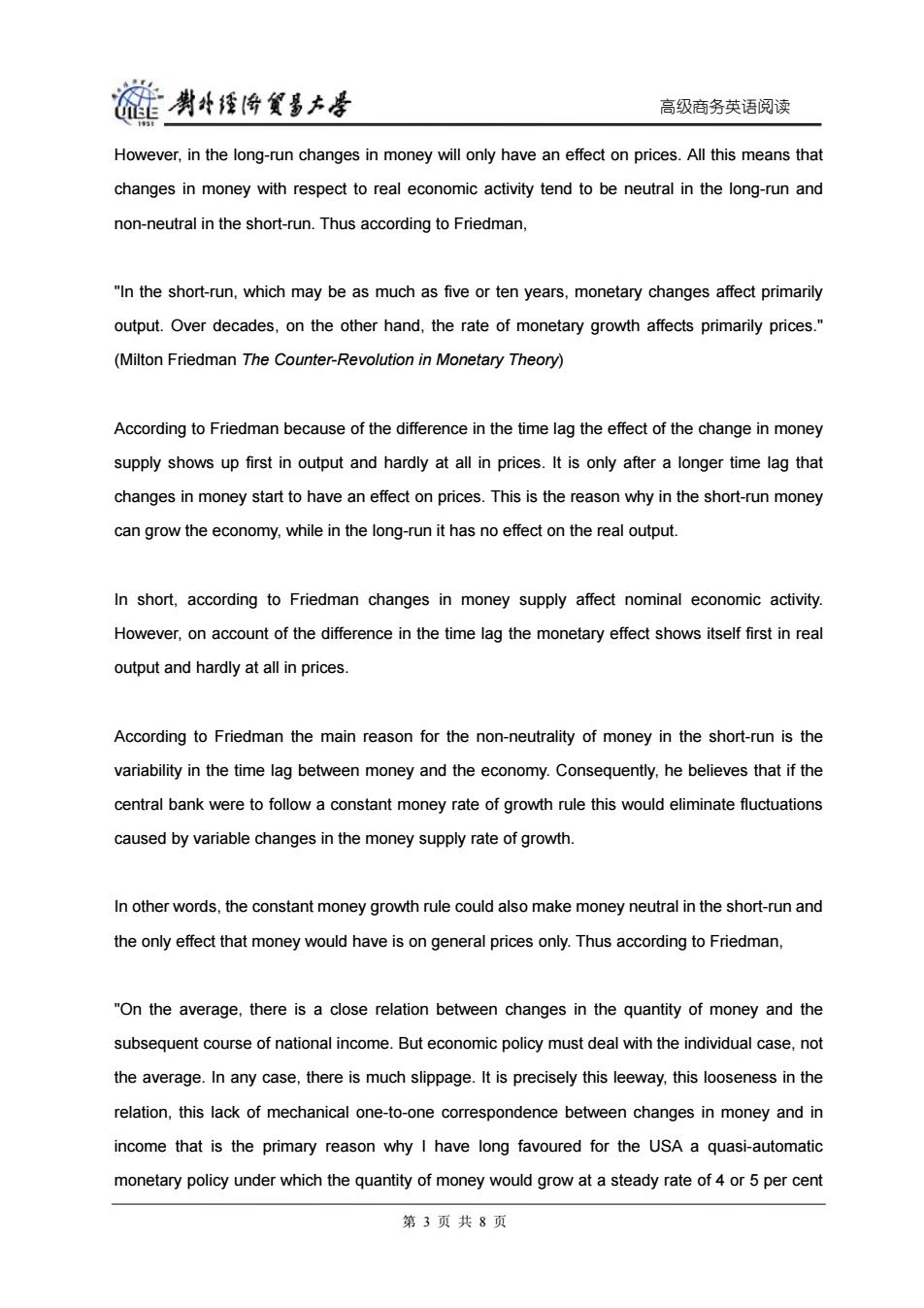
醛肖经海食多大是 高级商务英语阅读 However,in the long-run changes in money will only have an effect on prices.All this means that changes in money with respect to real economic activity tend to be neutral in the long-run and non-neutral in the short-run.Thus according to Friedman, "In the short-run,which may be as much as five or ten years,monetary changes affect primarily output.Over decades,on the other hand,the rate of monetary growth affects primarily prices." (Milton Friedman The Counter-Revolution in Monetary Theory) According to Friedman because of the difference in the time lag the effect of the change in money supply shows up first in output and hardly at all in prices.It is only after a longer time lag that changes in money start to have an effect on prices.This is the reason why in the short-run money can grow the economy,while in the long-run it has no effect on the real output. In short,according to Friedman changes in money supply affect nominal economic activity. However,on account of the difference in the time lag the monetary effect shows itself first in real output and hardly at all in prices. According to Friedman the main reason for the non-neutrality of money in the short-run is the variability in the time lag between money and the economy.Consequently,he believes that if the central bank were to follow a constant money rate of growth rule this would eliminate fluctuations caused by variable changes in the money supply rate of growth. In other words,the constant money growth rule could also make money neutral in the short-run and the only effect that money would have is on general prices only.Thus according to Friedman, "On the average,there is a close relation between changes in the quantity of money and the subsequent course of national income.But economic policy must deal with the individual case,not the average.In any case,there is much slippage.It is precisely this leeway,this looseness in the relation,this lack of mechanical one-to-one correspondence between changes in money and in income that is the primary reason why I have long favoured for the USA a quasi-automatic monetary policy under which the quantity of money would grow at a steady rate of 4 or 5 per cent 第3页共8页
高级商务英语阅读 However, in the long-run changes in money will only have an effect on prices. All this means that changes in money with respect to real economic activity tend to be neutral in the long-run and non-neutral in the short-run. Thus according to Friedman, "In the short-run, which may be as much as five or ten years, monetary changes affect primarily output. Over decades, on the other hand, the rate of monetary growth affects primarily prices." (Milton Friedman The Counter-Revolution in Monetary Theory) According to Friedman because of the difference in the time lag the effect of the change in money supply shows up first in output and hardly at all in prices. It is only after a longer time lag that changes in money start to have an effect on prices. This is the reason why in the short-run money can grow the economy, while in the long-run it has no effect on the real output. In short, according to Friedman changes in money supply affect nominal economic activity. However, on account of the difference in the time lag the monetary effect shows itself first in real output and hardly at all in prices. According to Friedman the main reason for the non-neutrality of money in the short-run is the variability in the time lag between money and the economy. Consequently, he believes that if the central bank were to follow a constant money rate of growth rule this would eliminate fluctuations caused by variable changes in the money supply rate of growth. In other words, the constant money growth rule could also make money neutral in the short-run and the only effect that money would have is on general prices only. Thus according to Friedman, "On the average, there is a close relation between changes in the quantity of money and the subsequent course of national income. But economic policy must deal with the individual case, not the average. In any case, there is much slippage. It is precisely this leeway, this looseness in the relation, this lack of mechanical one-to-one correspondence between changes in money and in income that is the primary reason why I have long favoured for the USA a quasi-automatic monetary policy under which the quantity of money would grow at a steady rate of 4 or 5 per cent 第 3 页 共 8 页
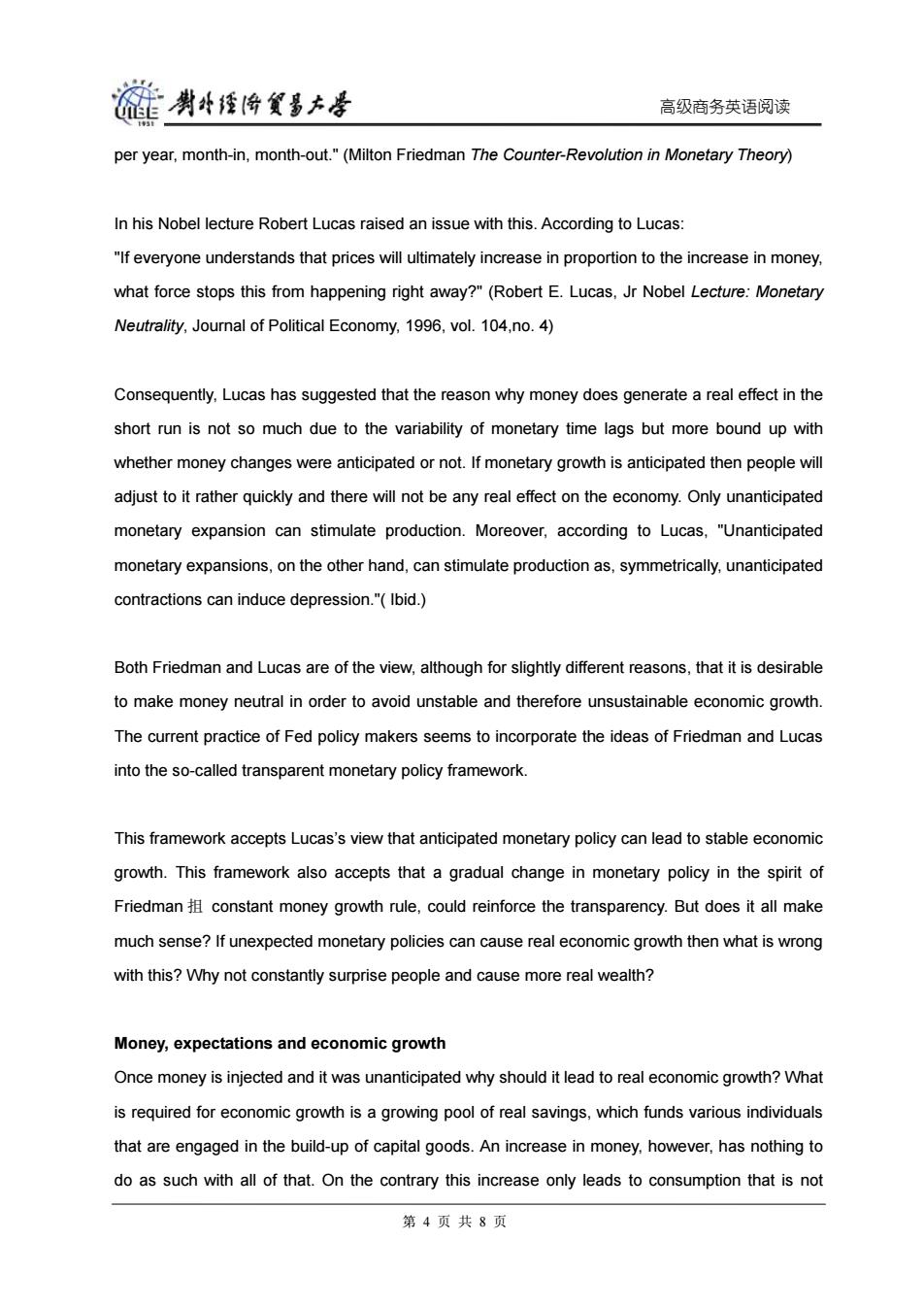
碰男降贸多大是 高级商务英语阅读 per year,month-in,month-out."(Milton Friedman The Counter-Revolution in Monetary Theory) In his Nobel lecture Robert Lucas raised an issue with this.According to Lucas: "If everyone understands that prices will ultimately increase in proportion to the increase in money, what force stops this from happening right away?"(Robert E.Lucas,Jr Nobel Lecture:Monetary Neutrality,Journal of Political Economy,1996,vol.104,no.4) Consequently,Lucas has suggested that the reason why money does generate a real effect in the short run is not so much due to the variability of monetary time lags but more bound up with whether money changes were anticipated or not.If monetary growth is anticipated then people will adjust to it rather quickly and there will not be any real effect on the economy.Only unanticipated monetary expansion can stimulate production.Moreover,according to Lucas,"Unanticipated monetary expansions,on the other hand,can stimulate production as,symmetrically,unanticipated contractions can induce depression."(Ibid.) Both Friedman and Lucas are of the view,although for slightly different reasons,that it is desirable to make money neutral in order to avoid unstable and therefore unsustainable economic growth. The current practice of Fed policy makers seems to incorporate the ideas of Friedman and Lucas into the so-called transparent monetary policy framework. This framework accepts Lucas's view that anticipated monetary policy can lead to stable economic growth.This framework also accepts that a gradual change in monetary policy in the spirit of Friedman constant money growth rule,could reinforce the transparency.But does it all make much sense?If unexpected monetary policies can cause real economic growth then what is wrong with this?Why not constantly surprise people and cause more real wealth? Money,expectations and economic growth Once money is injected and it was unanticipated why should it lead to real economic growth?What is required for economic growth is a growing pool of real savings,which funds various individuals that are engaged in the build-up of capital goods.An increase in money,however,has nothing to do as such with all of that.On the contrary this increase only leads to consumption that is not 第4页共8页
高级商务英语阅读 per year, month-in, month-out." (Milton Friedman The Counter-Revolution in Monetary Theory) In his Nobel lecture Robert Lucas raised an issue with this. According to Lucas: "If everyone understands that prices will ultimately increase in proportion to the increase in money, what force stops this from happening right away?" (Robert E. Lucas, Jr Nobel Lecture: Monetary Neutrality, Journal of Political Economy, 1996, vol. 104,no. 4) Consequently, Lucas has suggested that the reason why money does generate a real effect in the short run is not so much due to the variability of monetary time lags but more bound up with whether money changes were anticipated or not. If monetary growth is anticipated then people will adjust to it rather quickly and there will not be any real effect on the economy. Only unanticipated monetary expansion can stimulate production. Moreover, according to Lucas, "Unanticipated monetary expansions, on the other hand, can stimulate production as, symmetrically, unanticipated contractions can induce depression."( Ibid.) Both Friedman and Lucas are of the view, although for slightly different reasons, that it is desirable to make money neutral in order to avoid unstable and therefore unsustainable economic growth. The current practice of Fed policy makers seems to incorporate the ideas of Friedman and Lucas into the so-called transparent monetary policy framework. This framework accepts Lucas’s view that anticipated monetary policy can lead to stable economic growth. This framework also accepts that a gradual change in monetary policy in the spirit of Friedman 抯 constant money growth rule, could reinforce the transparency. But does it all make much sense? If unexpected monetary policies can cause real economic growth then what is wrong with this? Why not constantly surprise people and cause more real wealth? Money, expectations and economic growth Once money is injected and it was unanticipated why should it lead to real economic growth? What is required for economic growth is a growing pool of real savings, which funds various individuals that are engaged in the build-up of capital goods. An increase in money, however, has nothing to do as such with all of that. On the contrary this increase only leads to consumption that is not 第 4 页 共 8 页

碰男降贸多大是 高级商务英语阅读 supported by production of real wealth. Consequently,this leads to a weakening in the real pool of savings,which in tumn undermines real economic growth.In short,all that printing money can achieve is a redirection of real savings from wealth generating activities towards non-productive wealth consuming activities.So obviously there cannot be any economic growth as a result of this redirection. If anything,unanticipated monetary growth will undermine real economic growth via the dilution of the pool of real funding.Why is it then that one observes that rising money is associated with a rise in economic indicators like real GDP?All that we observe in reality is an increase in monetary spending-this is what GDP depicts.In other words,the more money is printed the higher GDP will be. So-called real GDP is just nominal GDP deflated by a meaningless price index.Hence so-called observed economic growth is just the reflection of monetary expansion and has nothing to do with real economic growth,which cannot be measured by quantitative methods. After all,it is not possible to establish a meaningful total by adding potatoes and tomatoes.So while unanticipated monetary growth cannot grow the economy it definitely produces a real effect by undermining the pool of real savings and thereby weakening the real economy. Likewise anticipated money growth cannot be harmless to the real economy.Even if the money rate of growth is fully anticipated there is always someone who gets it first.For instance,take an individual who fully expects the future course of monetary policy.This individual now decides to borrow $1000 from a bank.The bank obliges and lends him the $1000,which the bank has created out of "thin air". Now,since this money is unbacked by any previous production of real wealth it will set in motion an exchange of nothing for something,or a redirection of real savings from wealth generators towards the borrower of the newly created $1000.This redirection and hence real negative effect on the pool of savings cannot be prevented by an individuals correct expectation of monetary policies. Even if the money is pumped in such a way that everybody gets it instantaneously,changes in the 第5页共8页
高级商务英语阅读 supported by production of real wealth. Consequently, this leads to a weakening in the real pool of savings, which in turn undermines real economic growth. In short, all that printing money can achieve is a redirection of real savings from wealth generating activities towards non-productive wealth consuming activities. So obviously there cannot be any economic growth as a result of this redirection. If anything, unanticipated monetary growth will undermine real economic growth via the dilution of the pool of real funding. Why is it then that one observes that rising money is associated with a rise in economic indicators like real GDP? All that we observe in reality is an increase in monetary spending — this is what GDP depicts. In other words, the more money is printed the higher GDP will be. So-called real GDP is just nominal GDP deflated by a meaningless price index. Hence so-called observed economic growth is just the reflection of monetary expansion and has nothing to do with real economic growth, which cannot be measured by quantitative methods. After all, it is not possible to establish a meaningful total by adding potatoes and tomatoes. So while unanticipated monetary growth cannot grow the economy it definitely produces a real effect by undermining the pool of real savings and thereby weakening the real economy. Likewise anticipated money growth cannot be harmless to the real economy. Even if the money rate of growth is fully anticipated there is always someone who gets it first. For instance, take an individual who fully expects the future course of monetary policy. This individual now decides to borrow $1000 from a bank. The bank obliges and lends him the $1000, which the bank has created out of "thin air". Now, since this money is unbacked by any previous production of real wealth it will set in motion an exchange of nothing for something, or a redirection of real savings from wealth generators towards the borrower of the newly created $1000. This redirection and hence real negative effect on the pool of savings cannot be prevented by an individuals correct expectation of monetary policies. Even if the money is pumped in such a way that everybody gets it instantaneously, changes in the 第 5 页 共 8 页
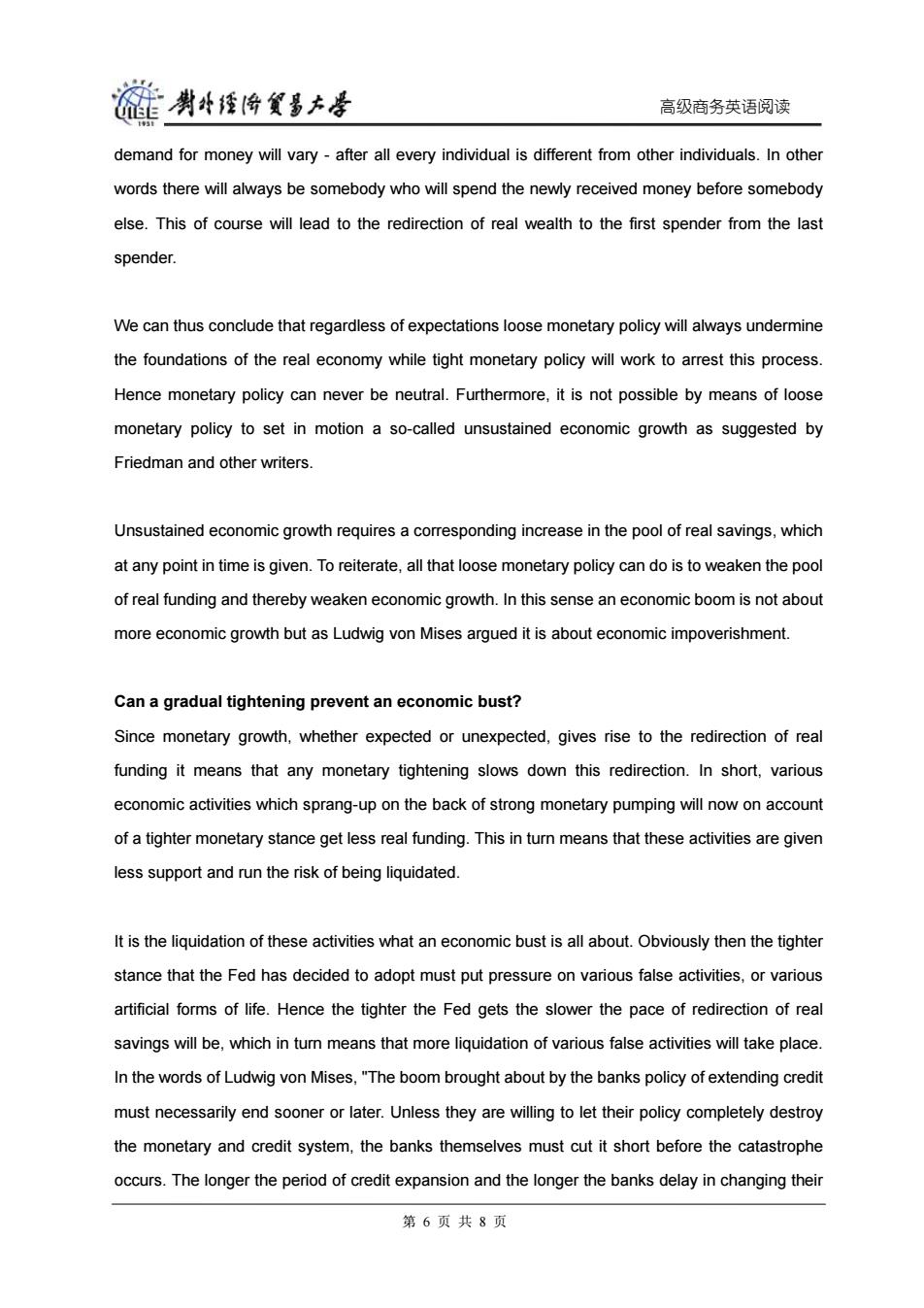
剥牛煙将多大是 高级商务英语阅读 demand for money will vary-after all every individual is different from other individuals.In other words there will always be somebody who will spend the newly received money before somebody else.This of course will lead to the redirection of real wealth to the first spender from the last spender. We can thus conclude that regardless of expectations loose monetary policy will always undermine the foundations of the real economy while tight monetary policy will work to arrest this process. Hence monetary policy can never be neutral.Furthermore,it is not possible by means of loose monetary policy to set in motion a so-called unsustained economic growth as suggested by Friedman and other writers. Unsustained economic growth requires a corresponding increase in the pool of real savings,which at any point in time is given.To reiterate,all that loose monetary policy can do is to weaken the pool of real funding and thereby weaken economic growth.In this sense an economic boom is not about more economic growth but as Ludwig von Mises argued it is about economic impoverishment. Can a gradual tightening prevent an economic bust? Since monetary growth,whether expected or unexpected,gives rise to the redirection of real funding it means that any monetary tightening slows down this redirection.In short,various economic activities which sprang-up on the back of strong monetary pumping will now on account of a tighter monetary stance get less real funding.This in turn means that these activities are given less support and run the risk of being liquidated. It is the liquidation of these activities what an economic bust is all about.Obviously then the tighter stance that the Fed has decided to adopt must put pressure on various false activities,or various artificial forms of life.Hence the tighter the Fed gets the slower the pace of redirection of real savings will be,which in turn means that more liquidation of various false activities will take place. In the words of Ludwig von Mises,"The boom brought about by the banks policy of extending credit must necessarily end sooner or later.Unless they are willing to let their policy completely destroy the monetary and credit system,the banks themselves must cut it short before the catastrophe occurs.The longer the period of credit expansion and the longer the banks delay in changing their 第6页共8页
高级商务英语阅读 demand for money will vary - after all every individual is different from other individuals. In other words there will always be somebody who will spend the newly received money before somebody else. This of course will lead to the redirection of real wealth to the first spender from the last spender. We can thus conclude that regardless of expectations loose monetary policy will always undermine the foundations of the real economy while tight monetary policy will work to arrest this process. Hence monetary policy can never be neutral. Furthermore, it is not possible by means of loose monetary policy to set in motion a so-called unsustained economic growth as suggested by Friedman and other writers. Unsustained economic growth requires a corresponding increase in the pool of real savings, which at any point in time is given. To reiterate, all that loose monetary policy can do is to weaken the pool of real funding and thereby weaken economic growth. In this sense an economic boom is not about more economic growth but as Ludwig von Mises argued it is about economic impoverishment. Can a gradual tightening prevent an economic bust? Since monetary growth, whether expected or unexpected, gives rise to the redirection of real funding it means that any monetary tightening slows down this redirection. In short, various economic activities which sprang-up on the back of strong monetary pumping will now on account of a tighter monetary stance get less real funding. This in turn means that these activities are given less support and run the risk of being liquidated. It is the liquidation of these activities what an economic bust is all about. Obviously then the tighter stance that the Fed has decided to adopt must put pressure on various false activities, or various artificial forms of life. Hence the tighter the Fed gets the slower the pace of redirection of real savings will be, which in turn means that more liquidation of various false activities will take place. In the words of Ludwig von Mises, "The boom brought about by the banks policy of extending credit must necessarily end sooner or later. Unless they are willing to let their policy completely destroy the monetary and credit system, the banks themselves must cut it short before the catastrophe occurs. The longer the period of credit expansion and the longer the banks delay in changing their 第 6 页 共 8 页
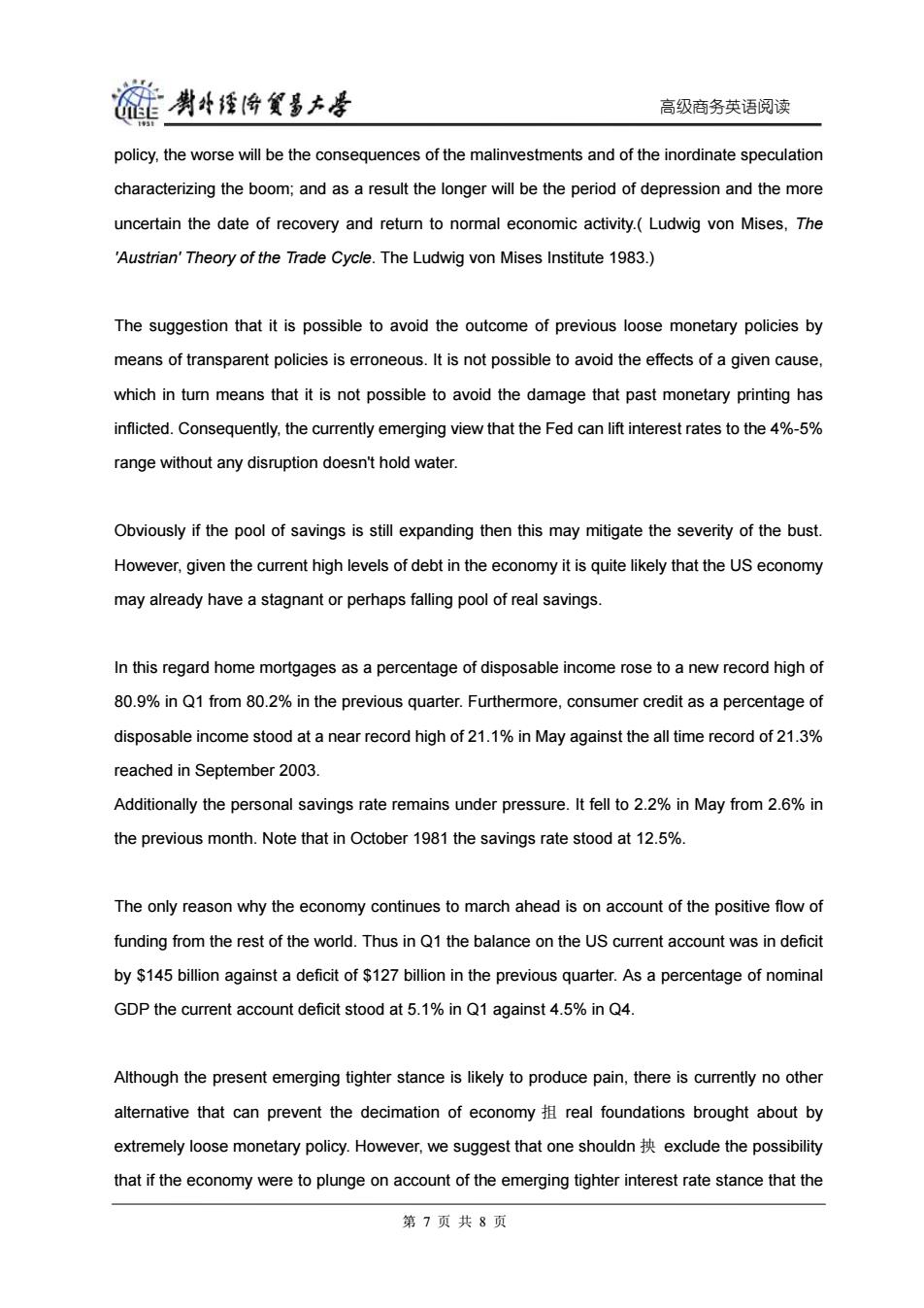
碰男华经海贸多大学 高级商务英语阅读 policy,the worse will be the consequences of the malinvestments and of the inordinate speculation characterizing the boom;and as a result the longer will be the period of depression and the more uncertain the date of recovery and return to normal economic activity.Ludwig von Mises,The 'Austrian'Theory of the Trade Cycle.The Ludwig von Mises Institute 1983.) The suggestion that it is possible to avoid the outcome of previous loose monetary policies by means of transparent policies is erroneous.It is not possible to avoid the effects of a given cause, which in turn means that it is not possible to avoid the damage that past monetary printing has inflicted.Consequently,the currently emerging view that the Fed can lift interest rates to the 4%-5% range without any disruption doesn't hold water. Obviously if the pool of savings is still expanding then this may mitigate the severity of the bust. However,given the current high levels of debt in the economy it is quite likely that the US economy may already have a stagnant or perhaps falling pool of real savings. In this regard home mortgages as a percentage of disposable income rose to a new record high of 80.9%in Q1 from 80.2%in the previous quarter.Furthermore,consumer credit as a percentage of disposable income stood at a near record high of 21.1%in May against the all time record of 21.3% reached in September 2003. Additionally the personal savings rate remains under pressure.It fell to 2.2%in May from 2.6%in the previous month.Note that in October 1981 the savings rate stood at 12.5%. The only reason why the economy continues to march ahead is on account of the positive flow of funding from the rest of the world.Thus in Q1 the balance on the US current account was in deficit by $145 billion against a deficit of $127 billion in the previous quarter.As a percentage of nominal GDP the current account deficit stood at 5.1%in Q1 against 4.5%in Q4. Although the present emerging tighter stance is likely to produce pain,there is currently no other alternative that can prevent the decimation of economy real foundations brought about by extremely loose monetary policy.However,we suggest that one shouldn exclude the possibility that if the economy were to plunge on account of the emerging tighter interest rate stance that the 第7页共8页
高级商务英语阅读 policy, the worse will be the consequences of the malinvestments and of the inordinate speculation characterizing the boom; and as a result the longer will be the period of depression and the more uncertain the date of recovery and return to normal economic activity.( Ludwig von Mises, The 'Austrian' Theory of the Trade Cycle. The Ludwig von Mises Institute 1983.) The suggestion that it is possible to avoid the outcome of previous loose monetary policies by means of transparent policies is erroneous. It is not possible to avoid the effects of a given cause, which in turn means that it is not possible to avoid the damage that past monetary printing has inflicted. Consequently, the currently emerging view that the Fed can lift interest rates to the 4%-5% range without any disruption doesn't hold water. Obviously if the pool of savings is still expanding then this may mitigate the severity of the bust. However, given the current high levels of debt in the economy it is quite likely that the US economy may already have a stagnant or perhaps falling pool of real savings. In this regard home mortgages as a percentage of disposable income rose to a new record high of 80.9% in Q1 from 80.2% in the previous quarter. Furthermore, consumer credit as a percentage of disposable income stood at a near record high of 21.1% in May against the all time record of 21.3% reached in September 2003. Additionally the personal savings rate remains under pressure. It fell to 2.2% in May from 2.6% in the previous month. Note that in October 1981 the savings rate stood at 12.5%. The only reason why the economy continues to march ahead is on account of the positive flow of funding from the rest of the world. Thus in Q1 the balance on the US current account was in deficit by $145 billion against a deficit of $127 billion in the previous quarter. As a percentage of nominal GDP the current account deficit stood at 5.1% in Q1 against 4.5% in Q4. Although the present emerging tighter stance is likely to produce pain, there is currently no other alternative that can prevent the decimation of economy 抯 real foundations brought about by extremely loose monetary policy. However, we suggest that one shouldn 抰 exclude the possibility that if the economy were to plunge on account of the emerging tighter interest rate stance that the 第 7 页 共 8 页
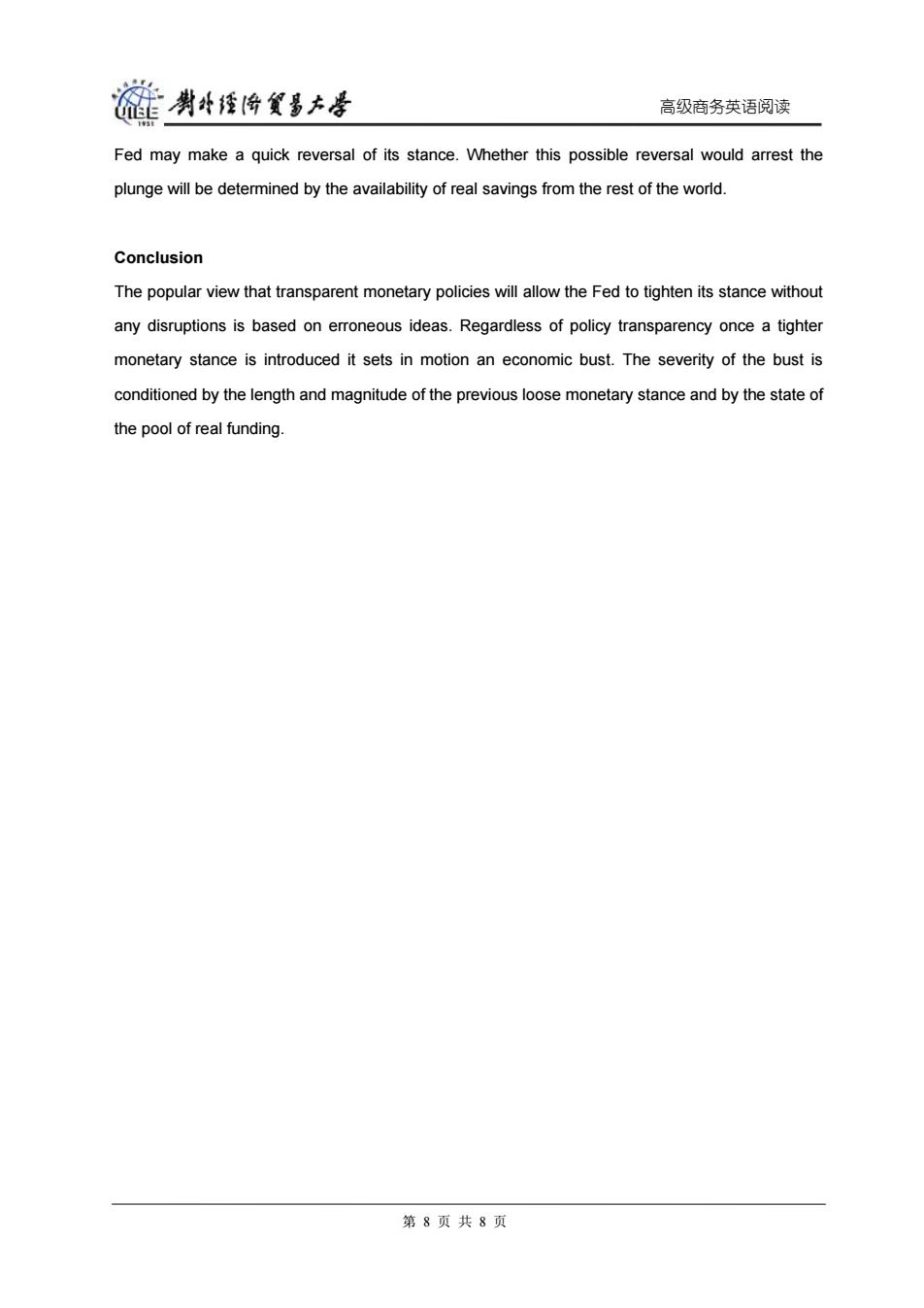
能男华锤降复多夫是 高级商务英语阅读 Fed may make a quick reversal of its stance.Whether this possible reversal would arrest the plunge will be determined by the availability of real savings from the rest of the world. Conclusion The popular view that transparent monetary policies will allow the Fed to tighten its stance without any disruptions is based on erroneous ideas.Regardless of policy transparency once a tighter monetary stance is introduced it sets in motion an economic bust.The severity of the bust is conditioned by the length and magnitude of the previous loose monetary stance and by the state of the pool of real funding. 第8页共8页
高级商务英语阅读 Fed may make a quick reversal of its stance. Whether this possible reversal would arrest the plunge will be determined by the availability of real savings from the rest of the world. Conclusion The popular view that transparent monetary policies will allow the Fed to tighten its stance without any disruptions is based on erroneous ideas. Regardless of policy transparency once a tighter monetary stance is introduced it sets in motion an economic bust. The severity of the bust is conditioned by the length and magnitude of the previous loose monetary stance and by the state of the pool of real funding. 第 8 页 共 8 页